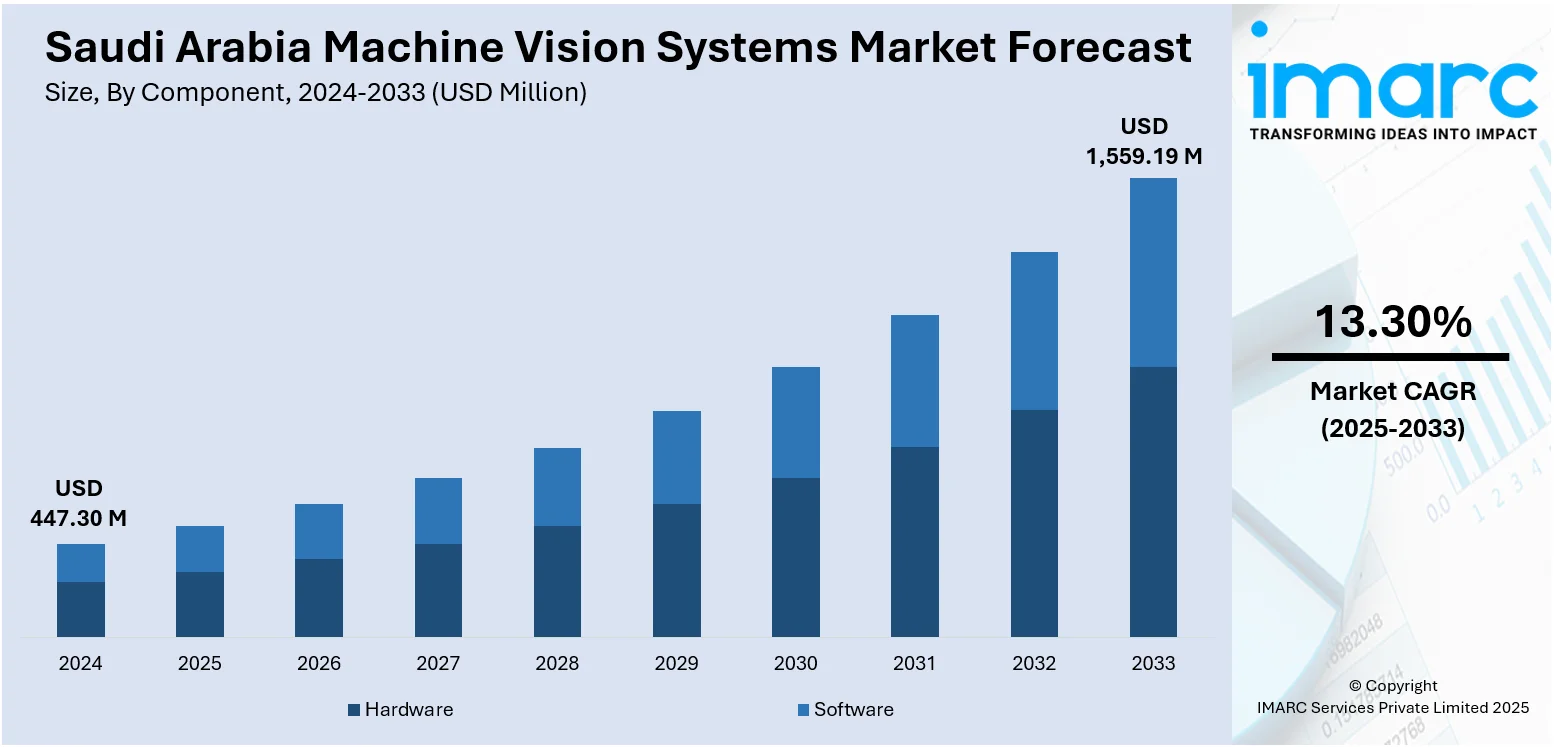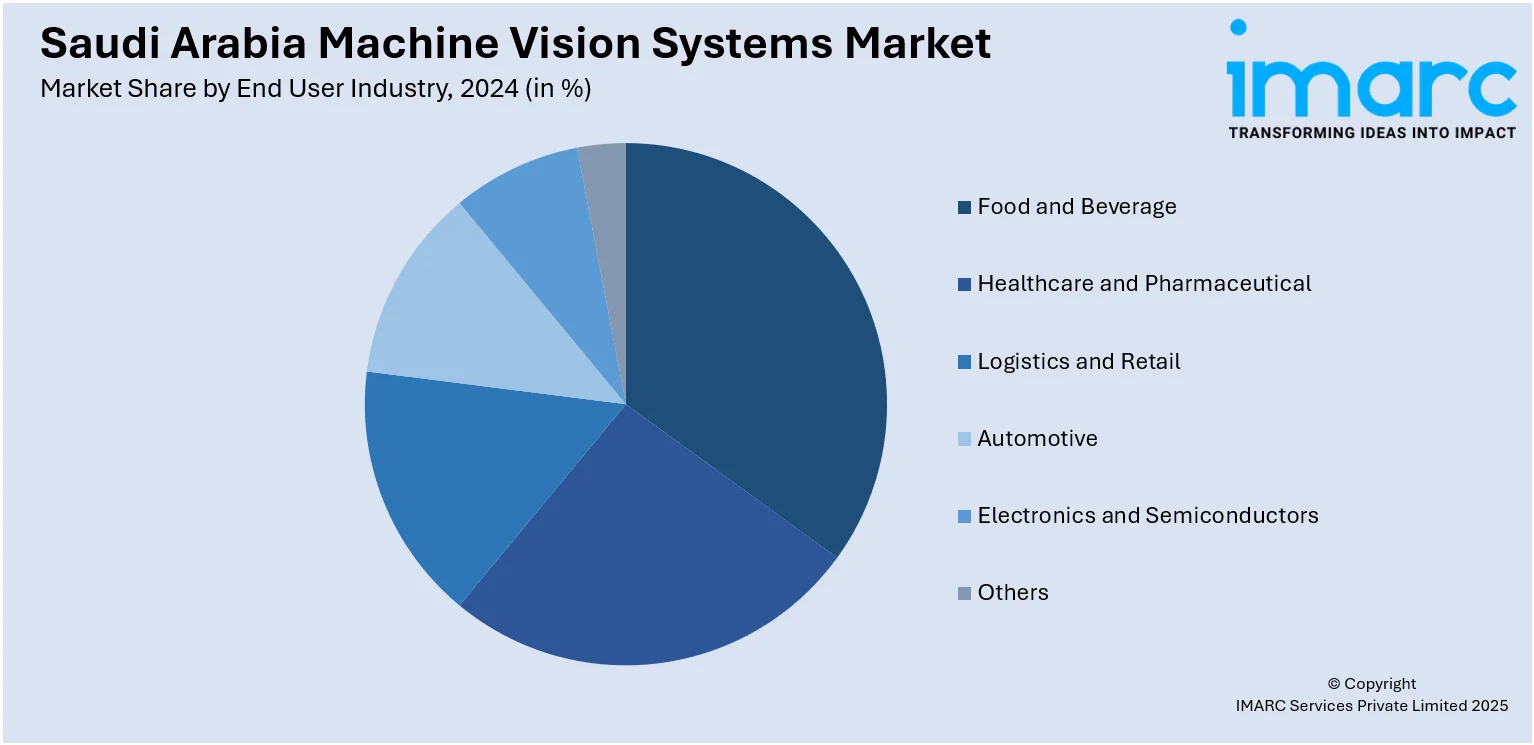
Saudi Arabia Machine Vision Systems Market Size, Share, Trends and Forecast by Component, Product, End User Industry, and Region, 2025-2033
Saudi Arabia Machine Vision Systems Market Overview:
The Saudi Arabia machine vision systems market size reached USD 447.30 Million in 2024. Looking forward, IMARC Group expects the market to reach USD 1,559.19 Million by 2033, exhibiting a growth rate (CAGR) of 13.30% during 2025-2033. The market is expanding due to rising automation across manufacturing, logistics, and security sectors. Enhanced demand for quality inspection, process control, and smart surveillance, along with technological advancements and government support for industrial modernization further boost growth, thereby strengthening the competitive landscape of the Saudi Arabia machine vision systems market share.
|
Report Attribute
|
Key Statistics
|
|---|---|
|
Base Year
|
2024
|
|
Forecast Years
|
2025-2033
|
|
Historical Years
|
2019-2024
|
| Market Size in 2024 | USD 447.30 Million |
| Market Forecast in 2033 | USD 1,559.19 Million |
| Market Growth Rate 2025-2033 | 13.30% |
Saudi Arabia Machine Vision Systems Market Trends:
Industrial Automation and Smart Manufacturing Initiatives
Saudi Arabia is rapidly embracing industrial automation as part of its Vision 2030 strategy to diversify its economy and modernize the manufacturing sector. Automation in many industries is made possible through functions like quality checking, finding errors and efficient workflow management provided by machine vision systems. They increase efficiency, decrease the chance of errors and help produce items that are consistently the same. Integrating machine vision is becoming more common in the automotive, electronics, food and beverage and pharmaceutical sectors for quicker and better inspections. Smart factories and Industry 4.0 are gaining popularity, leading to an increase in the demand for such technologies. Government-backed initiatives to localize production and strengthen non-oil industries further amplify the adoption of machine vision solutions in automated workflows.

To get more information on this market, Request Sample
Expansion of Logistics and E-Commerce Sectors
The rapid growth of e-commerce and logistics in Saudi Arabia has significantly boosted the need for machine vision systems in sorting, scanning, and tracking applications. Warehouses and distribution centers are turning to vision-based automation to improve operational efficiency, reduce delivery times, and ensure package accuracy. Machine vision supports real-time barcode reading, dimensional scanning, and visual inspections, all critical for large-scale fulfillment operations. The country’s strategic investments in logistics infrastructure, including smart ports and automated warehousing, drive further adoption of these technologies. As online shopping becomes more prevalent and last-mile delivery expectations rise, the logistics sector increasingly relies on machine vision systems to meet demand, maintain accuracy, and enhance the overall customer experience in a competitive digital economy.
Rising Demand for Quality Control in Manufacturing
As Saudi Arabia aims to enhance the quality and competitiveness of its domestically produced goods, quality assurance has become a top priority across industrial sectors. Machine vision systems enable precise, non-contact inspection methods that ensure product consistency and detect flaws in real time. From assembly verification to surface inspection and dimensional measurement, these systems are integral to maintaining high manufacturing standards. Sectors such as automotive, electronics, and packaging are leading adopters due to the need for reliable and scalable inspection processes. The push for export-ready products and reduced reliance on imports also reinforces the demand for stringent quality control. By minimizing defects and reducing waste, machine vision contributes to cost efficiency and brand reputation, driving the Saudi Arabia machine vision systems market growth.
Saudi Arabia Machine Vision Systems Market Segmentation:
IMARC Group provides an analysis of the key trends in each segment of the market, along with forecasts at the country and regional levels for 2025-2033. Our report has categorized the market based on component, product, and end user industry.
Component Insights:
- Hardware
- Vision Systems
- Cameras
- Optics and Illumination Systems
- Frame Grabbers
- Others
- Software
The report has provided a detailed breakup and analysis of the market based on the component. This includes hardware (vision systems, cameras, optics and illumination systems, frame grabbers, and others) and software.
Product Insights:
- PC-Based
- Smart Camera-Based
A detailed breakup and analysis of the market based on the product have also been provided in the report. This includes PC-based and smart camera-based.
End User Industry Insights:

- Food and Beverage
- Healthcare and Pharmaceutical
- Logistics and Retail
- Automotive
- Electronics and Semiconductors
- Others
A detailed breakup and analysis of the market based on the end user industry have also been provided in the report. This includes food and beverages, healthcare and pharmaceutical, logistics and retail, automotive, electronics and semiconductors, and others.
Regional Insights:
- Northern and Central Region
- Western Region
- Eastern Region
- Southern Region
The report has also provided a comprehensive analysis of all the major regional markets, which include the Northern and Central Region, Western Region, Eastern Region, and Southern Region.
Competitive Landscape:
The market research report has also provided a comprehensive analysis of the competitive landscape. Competitive analysis such as market structure, key player positioning, top winning strategies, competitive dashboard, and company evaluation quadrant has been covered in the report. Also, detailed profiles of all major companies have been provided.
Saudi Arabia Machine Vision Systems Market News:
- In May 2025, NVIDIA, the global leader in AI computing infrastructure, and HUMAIN, the new full AI value chain company of Saudi Arabia's Public Investment Fund, announced a historic strategic alliance to propel the advancement of artificial intelligence.
- In February 2025, IOTSQUARED, a PIF-backed firm and a subsidiary of Saudi Telecom (STC), formed a global strategic relationship with VIZZIO and POLYTRON at LEAP 2025, the leading technology exhibition in the Middle East. Using the most recent developments in Multi-Modal LLMs (Large Language Models), Agentic Vision AI, Transformer AI, and edge-to-cloud AI architectures, this historic partnership marks a revolutionary leap in AI-driven security and surveillance as well as City-Scale 3D city mapping using satellite imagery. It will revolutionize camera intelligence, urban informatics, and AI-POWERED 3D modeling and visualization technologies for lightning-fast digital twin production and development.
Saudi Arabia Machine Vision Systems Market Report Coverage:
| Report Features | Details |
|---|---|
| Base Year of the Analysis | 2024 |
| Historical Period | 2019-2024 |
| Forecast Period | 2025-2033 |
| Units | Million USD |
| Scope of the Report |
Exploration of Historical Trends and Market Outlook, Industry Catalysts and Challenges, Segment-Wise Historical and Future Market Assessment:
|
| Components Covered |
|
| Products Covered | PC-Based, Smart Camera-Based |
| End User Industries Covered | Food and Beverages, Healthcare and Pharmaceutical, Logistics and Retail, Automotive, Electronics and Semiconductors, Others |
| Regions Covered | Northern and Central Region, Western Region, Eastern Region, Southern Region |
| Customization Scope | 10% Free Customization |
| Post-Sale Analyst Support | 10-12 Weeks |
| Delivery Format | PDF and Excel through Email (We can also provide the editable version of the report in PPT/Word format on special request) |
Key Questions Answered in This Report:
- How has the Saudi Arabia machine vision systems market performed so far and how will it perform in the coming years?
- What is the breakup of the Saudi Arabia machine vision systems market on the basis of component?
- What is the breakup of the Saudi Arabia machine vision systems market on the basis of product?
- What is the breakup of the Saudi Arabia machine vision systems market on the basis of end user industry?
- What is the breakup of the Saudi Arabia machine vision systems market on the basis of region?
- What are the various stages in the value chain of the Saudi Arabia machine vision systems market?
- What are the key driving factors and challenges in the Saudi Arabia machine vision systems market?
- What is the structure of the Saudi Arabia machine vision systems market and who are the key players?
- What is the degree of competition in the Saudi Arabia machine vision systems market?
Key Benefits for Stakeholders:
- IMARC’s industry report offers a comprehensive quantitative analysis of various market segments, historical and current market trends, market forecasts, and dynamics of the Saudi Arabia machine vision systems market from 2019-2033.
- The research report provides the latest information on the market drivers, challenges, and opportunities in the Saudi Arabia machine vision systems market.
- Porter's five forces analysis assist stakeholders in assessing the impact of new entrants, competitive rivalry, supplier power, buyer power, and the threat of substitution. It helps stakeholders to analyze the level of competition within the Saudi Arabia machine vision systems industry and its attractiveness.
- Competitive landscape allows stakeholders to understand their competitive environment and provides an insight into the current positions of key players in the market.
Need more help?
- Speak to our experienced analysts for insights on the current market scenarios.
- Include additional segments and countries to customize the report as per your requirement.
- Gain an unparalleled competitive advantage in your domain by understanding how to utilize the report and positively impacting your operations and revenue.
- For further assistance, please connect with our analysts.
 Request Customization
Request Customization
 Speak to an Analyst
Speak to an Analyst
 Request Brochure
Request Brochure
 Inquire Before Buying
Inquire Before Buying




.webp)




.webp)












